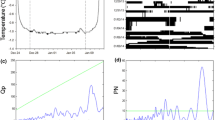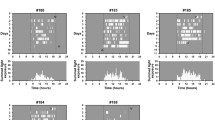Abstract
Circadian rhythms are regulated by an internal clock, which is itself synchronized to environmental cues such as light and temperature. It is widely assumed that the circadian system is adapted to local cues, which vary enormously across habitats, yet the comparative data necessary for testing this idea are lacking. We examined photic and thermal resetting of the circadian clock in five species of Anolis lizards whose microhabitats differ in the amounts of sun and shade. The primary circadian oscillator in Anolis is the pineal gland, which produces the hormone melatonin. A flow-through culture system was employed to measure rhythmic melatonin output from individually cultured pineal glands. All species showed temperature-compensated circadian rhythms of pineal melatonin. Light caused significant phase delays of the melatonin rhythm, and this effect varied among species. Controlling for phylogenetic differences, the results indicate that the pineal glands of shade-dwelling species are more sensitive to photic resetting than species living in more brightly illuminated habitats. The differences were not due to variation in free-running period, but may be due to variation in oscillator phase and/or robustness. Surprisingly, thermal resetting was not statistically significant. Overall, the results suggest that the Anolis circadian system is adapted to photic habitat.





Similar content being viewed by others
References
Aschoff J (1981a) Handbook of behavioral neurobiology, vol 4. Plenum Press, New York
Aschoff J (1981b) Freerunning and entrained circadian rhythms. In: Handbook of behavioral neurobiology, vol 4. Plenum Press, New York City
Aschoff J, Pohl H (1978) Phase relations between a circadian rhythm and its zeitgeber within the range of entrainment. Naturwissenschaften 65:80–84
Barrett RK, Takahashi JS (1995) Temperature compensation and temperature entrainment of the chick pineal cell circadian clock. J Neurosci 15:5681–5692
Bertolucci C, Wagner G, Foà A, Gwinner E, Brandstätter R (2003) Photoperiod affects amplitude but not duration of in vitro melatonin production in the ruin lizard (Podarcis sicula). J Biol Rhythms 18:63–70
Currie J, Goda T, Wijnen H (2009) Selective entrainment of the Drosophila circadian clock to daily gradients in environmental temperature. BMC Biol 7:49
Endler JA (1992) Signals, signal conditions, and the direction of evolution. Am Nat 139(Supplement):S125–S153
Fleishman LJ, Persons M (2001) The influence of stimulus and background colour on signal visibility in the lizard Anolis cristatellus. J Exp Biol 204:1559–1575
Fleishman LJ, Bowman M, Saunders D, Miller WE, Rury MJ, Loew ER (1997) The visual ecology of Puerto Rican anoline lizards: habitat light and spectral sensitivity. J Comp Physiol A 181:446–460
Fleishman LJ, Leal M, Persons MH (2009) Habitat light and dewlap color diversity in four species of Puerto Rican anoline lizards. J Comp Physiol A 195:1043–1060
Glaser FT, Stanewsky R (2007) Synchronization of the Drosophila circadian clock by temperature cycles. Cold Spring Harb Symp Quant Biol 72:233–242
Golombek D, Rosenstein R (2009) Physiology of circadian entrainment. Physiol Rev 90:1063–1102
Gorman G, Hillman S (1977) Physiological basis for climatic niche partitioning in two species of Puerto Rican Anolis (Reptilia, Lacertilia, Iguanidae). J Herpetol 11:337–340
Hau M, Gwinner E (1994) Melatonin facilitates synchronization of sparrow circadian rhythms to light. J Comp Physiol A 175:343–347
Hertz PE (1992a) Evaluating thermal resource partitioning by sympatric lizards Anolis cooki and A. cristatellus: a field test using null hypotheses. Oecologia 90:127–136
Hertz PE (1992b) Temperature regulation in Puerto Rican Anolis lizards: a field test using null hypotheses. Ecology 73:1405–1417
Hoffmann K (1969) Zum Einfluss der Zeitgeberstärke auf die Phasenlage der synchronisierten circadianen Periodik. Z vergl Physiol 62:93–110
Huey RB, Webster TP (1976) Thermal biology of Anolis lizards in a complex fauna: the Cristatellus group on Puerto Rico. Ecology 57:985–994
Hut RA, Beersma DG (2010) Evolution of time-keeping mechanisms: early emergence and adaptation to photoperiod. Phil Trans R Soc Lond B 366:2141–2154
Hyde LL, Underwood H (2000) Effects of melatonin administration on the circadian activity rhythm of the lizard Anolis carolinensis. Physiol Behav 71:183–192
Jackman TR, Larson A, de Queiroz K, Losos JB (1999) Phylogenetic relationships and tempo of early diversification in Anolis lizards. Syst Biol 48:254–285
Johnson CH (2005) Testing the adaptive value of circadian systems. Methods Enzymol 393:818–837
Kyriacou CP, Peixoto AA, Sandrelli F, Costa R, Tauber E (2008) Clines in clock genes: fine-tuning circadian rhythms to the environment. Trends Genet 24:124–132
Leal M (2004) Differences in visual signal design and detectability between allopatric populations of Anolis lizards. Am Nat 163:26–39
Leal M, Fleishman LJ (2002) Evidence for habitat partitioning based on adaptation to environmental light in a pair of sympatric lizard species. Proc Biol Sci 269:351–359
Lincoln GA, Clarke IJ, Hut RA, Hazlerigg DG (2006) Characterizing a mammalian circannual pacemaker. Science 314:1941–1944
Loew ER, Fleishman LJ, Foster RG, Provencio I (2002) Visual pigments and oil droplets in diurnal lizards: a comparative study of Caribbean anoles. J Exp Biol 205:927–938
Losos JB (2009) Lizards in an evolutionary tree: the ecology of adaptive radiation in anoles. University of California Press, Berkeley
Lythgoe JN (1979) The ecology of vision. Clarendon Press, New York
Macedonia J, Echternacht A, Walguarnery J (2003) Color variation, habitat light, and background contrast in Anolis carolinensis along a geographical transect in Florida. J Herpetol 37:467–478
Menaker M, Tosini G (1996) The evolution of vertebrate circadian systems. In: Honma K, Honma S (eds) Sixth Sapporo symposium on biological rhythms: circadian organization and oscillatory coupling. Hokkaido University Press, Sapporo, pp 39–52
Menaker M, Wisner S (1983) Temperature-compensated circadian clock in the pineal of Anolis. Proc Natl Acad Sci USA 80:6119–6121
Moore AF, Menaker M (2011) The effect of light on melatonin secretion in the cultured pineal glands of Anolis lizards. Comp Biochem Physiol A 160:301–308
Mrosovsky N, Hattar S (2005) Diurnal mice (Mus musculus) and other examples of temporal niche switching. J Comp Physiol A 191:1011–1024
Nicholson K, Glor R, Kolbe J, Larson A, Hedges S, Losos JB (2005) Mainland colonization by island lizards. J Biogeogr 32:929–938
Peirson SN, Halford S, Foster RG (2009) The evolution of irradiance detection: melanopsin and the non-visual opsins. Phil Trans R Soc Lond B 364:2849–2865
Pittendrigh C (1981) Circadian systems: entrainment. In: Aschoff J (ed) Handbook for behavioral neurobiology, vol 4. Plenum, New York, pp 95–124
Pittendrigh C, Daan S (1976) A functional analysis of circadian pacemakers in rodents. IV. Entrainment: pacemaker as clock. J Comp Physiol 106:291–331
Pohl H (1976) Proportional effect of light on entrained circadian rhythms of birds and mammals. J Comp Physiol A 112:103–108
Rand AS (1964) Ecological distribution in anoline lizards of Puerto Rico. Ecology 45:745–752
Rensing L, Ruoff P (2002) Temperature effect on entrainment, phase shifting, and amplitude of circadian clocks and its molecular basis. Chronobiol Int 19:807–864
Rollag MD, Niswender GD (1976) Radioimmunoassay of serum concentrations of melatonin in sheep exposed to different lighting regimens. Endocrinology 98:482–489
Roughgarden J (1981) Resource partitioning of space and its relationship to body temperature in Anolis lizard populations. Oecologia 50:256–264
Ruibal R (1961) Thermal relations of five species of tropical lizards. Evolution 15:98–111
Schoener TW (1974) Resource partitioning in ecological communities. Science 185:27–39
Underwood H (1983a) Circadian organization in the lizard Anolis carolinensis: a multioscillator system. J Comp Physiol A 152:265–274
Underwood H (1983b) Circadian pacemakers in lizards: phase-response curves and effects of pinealectomy. Am J Physiol 244:R857–R864
Underwood H (1985) Pineal melatonin rhythms in the lizard Anolis carolinensis: effects of light and temperature cycles. J Comp Physiol A 157:57–65
Underwood H (1986) Light at night cannot suppress pineal melatonin levels in the lizard Anolis carolinensis. Comp Biochem Physiol A 84:661–663
Underwood H, Calaban M (1987) Pineal melatonin rhythms in the lizard Anolis carolinensis: I. Response to light and temperature cycles. J Biol Rhythms 2:179–193
Williams EE (1972) The origin of faunas. Evolution of lizard congeners in a complex island fauna: a trial analysis. Evol Biol 6:47–89
Williams EE (1983) Ecomorphs, faunas, island size, and diverse endpoints in island radiations of Anolis. Harvard University Press, Cambridge
Acknowledgments
We gratefully acknowledge the contributions of Dr. Roelof Hut, who wrote the curve-fitting macro and made useful suggestions for sine wave analysis and interpretation. We also thank Dr. Mark Rollag for the donation of melatonin antiserum and for indispensable technical advice, as well as Dr. Edmund Brodie III for equipment and helpful discussion. Animal care and laboratory assistance was provided by Ralph Ababio, Brian Barry, Maridel Fredericksen, Kelly Underwood, and Emily Wrona. Special thanks go to the Departamento de Recursos Naturales y Ambientales of Puerto Rico for allowing us to collect animals from public land. For assistance with animal capture, we thank Dr. Paul Bartell, Dr. Eric Liebgold, Sarah Steiner, and Helen Vasaly. Funding for this project was provided by National Science Foundation Doctoral Dissertation Improvement Grant 0910075 awarded to AFM, MM, and EDB.
Author information
Authors and Affiliations
Corresponding author
Electronic supplementary material
Below is the link to the electronic supplementary material.
359_2012_715_MOESM1_ESM.tif
Online Resource 1. Representative melatonin profiles with fitted sine curves. Melatonin concentrations (unfilled circles) from individual pineal cultures are plotted over time (h in constant conditions). Shown here is a representative profile (one for each species) from the control groups of the light pulse experiment. Only data from the “constant conditions” portion of the cultures were used for curve fitting. The sine wave function (solid line) was fit to the data using non-linear regression (see text) and used to estimate circadian parameters such as phase and free-running period. The mean parameter estimates for each treatment group within each species, along with the fit statistics, are summarized in Table 1 (TIFF 46181 kb)
359_2012_715_MOESM2_ESM.tif
Online Resource 2. Rayleigh plots illustrating the effect of warm temperature pulse treatment on circadian phase of the pineal melatonin rhythm. Circular plots represent one complete circadian cycle of 24 circadian hours (CT). Phases of individual pineal cultures (in CT h) are represented by small circles on the perimeter of the circular plots (black control pineals; gray warm pulse-treated pineals). The arrows represent mean vectors of the circular distributions for each group; the angle of the arrow indicates the mean phase while the length of the arrow is proportional to the phase clustering (a longer arrow reflects more tightly clustered individual phases). The warm temperature pulse treatment caused a small delay in the mean phase of the pineal melatonin rhythm; however, this effect was not statistically significant. Sample sizes and values for phase, vector length r, and circular statistics are given in Table 2 (TIFF 18460 kb)
Rights and permissions
About this article
Cite this article
Moore, A.F., Menaker, M. Photic resetting of the circadian clock is correlated with photic habitat in Anolis lizards. J Comp Physiol A 198, 375–387 (2012). https://doi.org/10.1007/s00359-012-0715-4
Received:
Revised:
Accepted:
Published:
Issue Date:
DOI: https://doi.org/10.1007/s00359-012-0715-4




